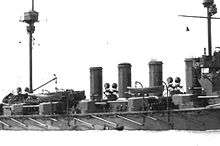BL 7.5-inch Mk II – V naval gun
| Ordnance BL 7.5-inch gun Mk II - Mk V | |
|---|---|
|
Turrets for HMS Shannon under construction at the Vickers Works, Barrow | |
| Type |
Naval gun Coast defence gun |
| Place of origin |
|
| Service history | |
| In service | 1905–20 |
| Used by |
Royal Navy British India |
| Wars | World War I |
| Production history | |
| Variants | Mks II, II*, II**, III, IV, V |
| Specifications | |
| Weight | 14½ - 16 tons barrel & breech |
| Barrel length | 375 inches (9,520 mm); (50 calibre) |
|
| |
| Shell | 200 pounds (90.7 kg) |
| Calibre | 7.5 inches (191 mm) |
| Muzzle velocity | 2,765 to 2,840 feet per second (843 to 866 m/s)[1] |
| Maximum firing range | 14,200 yards (13,000 m)[2] |
The BL 7.5-inch guns Mk II - Mk V[note 1] were a variety of 50-calibre naval guns used by Britain in World War I. They all had similar performance and fired the same shells.
History
Mark II
Mark II guns were originally developed to suit India's coast defence requirements. During World War I several reserve guns made for India but still in the UK were employed as coast defence guns in the UK. They were scrapped or sent to India soon after the war.[3]
Marks II*, II**, V

These were built and employed specifically as naval guns and were mounted as secondary armament as a heavier alternative to 6-inch guns, on the following ships :
- Warrior-class armoured cruisers laid down 1903–04, commissioned 1906–07
- Minotaur-class armoured cruisers laid down 1905, commissioned 1908–09
Mark III


Mark III guns were built by Elswick Ordnance to arm the battleship Constitución they were building for Chile. Britain acquired them by default when she bought Constitución in 1903 to avoid the risk of the ship being acquired by Russia. Constitución became HMS Swiftsure in British service.
Swiftsure was decommissioned in 1917 and her guns were used for coast defence in Britain, as siege guns on the Belgian coast near Nieuport for attacking German batteries, and on M15-class monitors.
Mark IV
Mark IV guns were made by Vickers for the battleship Libertad they were building for Chile. Britain acquired them by default in 1903 when she bought Libertad together with Constitución. Libertad became HMS Triumph in British service.
Surviving examples
- Two Mk II coast-defence guns made by E.O.C. in 1905 and R.G.F. in 1906, on Elephanta Island, Mumbai, India. Photographs on Flickr
See also
Notes
- ↑ Britain used Roman numerals to designate versions or models ("Mark" abbreviated as "Mk") until after World War II. Hence this articles covers the second through fifth model/version/Mark of British BL 7.5-inch naval guns
References
- ↑ Mk II (coast defence) : 2840 ft/second with 62 lb 12 oz cordite MD size 26 (Special for India)(Hogg & Thurston 1972 page 151); Mk II* & V : 2800 ft/second with 61 lb cordite MD size 26 ; Mk III & IV : 2765 ft/second with 54 lb 4 oz cordite MD size 26 (Range Tables for His Majesty's Fleet, 1910 February, 1911) & Treatise on Ammunition 1915.
- ↑ Mk II coast defence gun. Hogg & Thurston 1972, p. 151
- ↑ Hogg & Thurston 1972, p. 150
Bibliography
- Hogg, I.V. and Thurston, L.F. (1972). British Artillery Weapons & Ammunition 1914-1918. Ian Allan, London.
- Tony DiGiulian, British 7.5"/50 (19 cm) Mark III 7.5"/50 (19 cm) Mark IV
- Tony DiGiulian, British 7.5"/50 (19 cm) Mark II 7.5"/50 (19 cm) Mark V
External links
| Wikimedia Commons has media related to BL 7.5 inch Mk II - V naval gun. |
